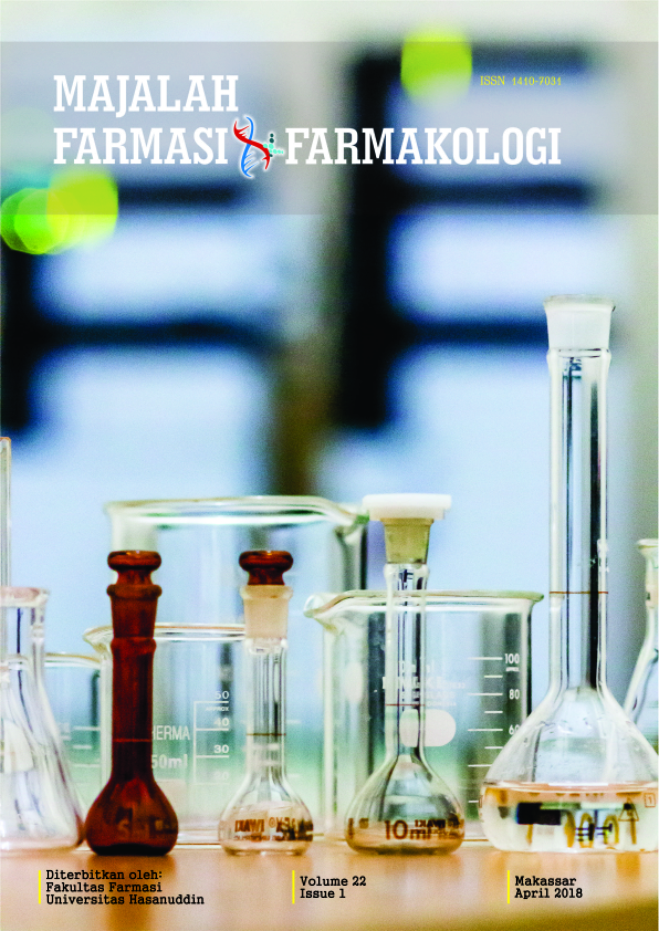PENGARUH PEMBERIAN EKSTRAK AIR ROSELLA (Hibiscus sabdariffa L) TERENKAPSULASI MALTODEXTRIN TERHADAP PEROKSIDASI LIPID HATI DAN GINJAL TIKUS WISTAR JANTAN YANG DIINDUKSI ISONIAZID-RIFAMPISIN
Abstract
Isoniazid dan rifampisin merupakan obat lini pertama antituberkulosis, namun kombinasi dari keduanya dapat meningkatkan resiko toksisitas pada hati dan ginjal. Kelopak bunga Rosella memiliki kandungan senyawa antioksidan yang dapat bersifat sitoprotektif. Tujuan dari penelitian ini adalah untuk mengevaluasi efek protektif ekstrak air bunga rosella terenkapsulasi maltodextrin terhadap peroksidasi lipid organ hati dan ginjal tikus jantan yang diinduksi isoniazid-rifampisin dosis toksik melalui pemeriksaan kadar malondialdehid (MDA). Sebanyak 25 ekor tikus wistar jantan dibagi ke dalam 5 kelompok. Kelompok I merupakan kontrol sehat, kelompok II diberi penginduksi isoniazid-rifampisin dosis toksik (50 mg/kg dan 100 mg/kg), kelompok III diberi isoniazid-rifampisin dan ekstrak rosella 62.5 mg/kgBB, kelompok IV diberi isoniazid-rifampisin dan ekstrak rosella 125 mg/kgBB, dan kelompok V diberi isoniaid-rifampisin dan ekstrak rosella 250 mg/kgBB. Tikus diberi ekstrak Rosella secara peroral 4 jam sebelum induksi isoniazid-rifampisin. Setelah 35 hari perlakuan, tikus dieutanasia dan dilakukan pemeriksaan MDA organ hati dan ginjal menggunakan spektrofotometer UV-Vis. Pemberian isoniazid-rifampisin dosis toksik selama 35 hari mampu meningkatkan MDA hati dan MDA ginjal lebih dari 3x lipat MDA hati tikus kontrol (p<0.01). Sedangkan, pemberian perlakuan ekstrak Rosella dosis 62.5 mg/kgBB, 125 mg/kgBB, 250 mg/kgBB mampu mempertahankan kadar MDA hati dan ginjal tikus setara dengan kontrol sehat. Dapat disimpulkan bahwa ekstrak rosella terenkapsulasi maltodextrin mampu mencegah peningkatan aktivitas peroksidasi lipid hati dan ginjal tikus yang diinduksi isoniazid-rifampisin pada dosis 62.5 mg/kgBB, 125 mg/kgBB, dan 250 mg/kgBB.
References
Shang, P., Xia, Y., Liu, F., Wang, X., Yuan, Y., Hu, D., et al. Incidence, clinical features and impact on anti-tuberculosis treatment of anti-tuberculosis drug induced liver injury (ATLI) in China. PLoS One, 2011; 6(7): e21836.
Baghaei, P., Tabarsi, P., Chitsaz, E., Saleh, M., Marjani, M., Shemirani, S., et al. Incidence, clinical and epidemiological risk factors, and outcome of drug-induced hepatitis due to antituberculous agents in new tuberculosis cases. American journal of therapeutics, 2010;17(1): 17-22.
Khalili, H., Dashti-Khavidaki, S., Rasoolinejad, M., Rezaie, L., and Etminani, M. Anti-tuberculosis drugs related hepatotoxicity; incidence, risk factors, pattern of changes in liver enzymes and outcome. Daru, 2009;17(3).
Ohno, M., Yamaguchi, I., Yamamoto, I., Fukuda, T., Yokota, S., Maekura, R., et al. Slow N-acetyltransferase 2 genotype affects the incidence of isoniazid and rifampicin-induced hepatotoxicity. The International Journal of Tuberculosis and Lung Disease,2000; 4(3): 256-261.
Askgaard, D.S., Wilcke, T., and Døssing, M. Hepatotoxicity caused by the combined action of isoniazid and rifampicin. Thorax, 1995; 50(2): 213-214.
Tafazoli, S., Mashregi, M., and O'brien, P.J. Role of hydrazine in isoniazid-induced hepatotoxicity in a hepatocyte inflammation model. Toxicology and applied pharmacology, 2008; 229(1): 94-101.
Yue, J., and Peng, R. Does CYP2E1 play a major role in the aggravation of isoniazid toxicity by rifampicin in human hepatocytes? British journal of pharmacology, 2009' 157(3): 331-333.
Fuhr, U. Induction of drug metabolising enzymes. Clinical pharmacokinetics,2000; 38(6): 493-504.
Wen, X., Wang, J.-S., Neuvonen, P.J., and Backman, J.T. Isoniazid is a mechanism-based inhibitor of cytochrome P 450 1A2, 2A6, 2C19 and 3A4 isoforms in human liver microsomes. European journal of clinical pharmacology, 2002; 57(11): 799-804.
Covic, A., Goldsmith, D., Segall, L., Stoicescu, C., Lungu, S., Volovat, C., et al. Rifampicin-induced acute renal failure: a series of 60 patients. Nephrology, dialysis, transplantation: official publication of the European Dialysis and Transplant Association-European Renal Association, 1998;13(4): 924-929.
Chowdhury, A., Santra, A., Bhattacharjee, K., Ghatak, S., Saha, D.R., and Dhali, G.K. Mitochondrial oxidative stress and permeability transition in isoniazid and rifampicin induced liver injury in mice. Journal of hepatology, 2006;45(1): 117-126.
Pedraza-Chaverri, J., Yam-Canul, P., Chirino, Y.I., Sánchez-González, D.J., Martínez-Martínez, C.M., Cruz, C., et al. Protective effects of garlic powder against potassium dichromate-induced oxidative stress and nephrotoxicity. Food and chemical toxicology, 2008;46(2): 619-627.
Lin, H.-H., Chen, J.-H., and Wang, C.-J. Chemopreventive properties and molecular mechanisms of the bioactive compounds in Hibiscus sabdariffa Linne. Current medicinal chemistry, 2011;18(8): 1245-1254.
Sarr, M., Ngom, S., Kane, M.O., Wele, A., Diop, D., Sarr, B., et al. In vitro vasorelaxation mechanisms of bioactive compounds extracted from Hibiscus sabdariffa on rat thoracic aorta. Nutrition & metabolism, 2009;6(1): 45.
Da-Costa-Rocha, I., Bonnlaender, B., Sievers, H., Pischel, I., and Heinrich, M. Hibiscus sabdariffa L.–A phytochemical and pharmacological review. Food chemistry,2014; 165: 424-443.
Fakeye, T.O., Pal, A., Bawankule, D., Yadav, N., and Khanuja, S. Toxic effects of oral administration of extracts of dried calyx of Hibiscus sabdariffa Linn (Malvaceae). Phytotherapy research, 2009;23(3): 412-416. (16)
Djide, M.N., Sartini, Amir., M.N., and Juniarti, N.. Pengembangan Formula Ekstrak Kelopak Bunga Rosella (Hibiscus sabdariffa L.) Terstandar Sebagai Terap Alternatif/Supportif dalam Mengatasi Resistensi Obat Antituberkulosis. (Laporan Penelitian). Makassar: Universitas Hasanuddin.2017
Che Man, Y.B., Irwandi, J., and Abdullah, W.J.W. Effect of different types of maltodextrin and drying methods on physico‐chemical and sensory properties of encapsulated durian flavour. Journal of the Science of Food and Agriculture,1999; 79(8): 1075-1080.
Karumi, Y., Addy, E., and Ugonna, O. The Protective Effect of Aqueous Extract of the Calyx of Hibiscus sabdariffa Roselle on the Kidneys of Salt-Loaded Rats. Journal of Medical Laboratory Science, 2013;12(1): 46-52.
Nafizah, A.H.N., Budin, S.B., Zaryantey, A.H., Mariati, A.R., Santhana, R.L., Osman, M., et al. Aqueous calyxes extract of Roselle or Hibiscus sabdariffa Linn supplementation improves liver morphology in streptozotocin induced diabetic rats. Arab journal of gastroenterology, 2017;18(1): 13-20.
Yin, G., Cao, L., Xu, P., Jeney, G., and Nakao, M. Hepatoprotective and antioxidant effects of Hibiscus sabdariffa extract against carbon tetrachloride-induced hepatocyte damage in Cyprinus carpio. In Vitro Cellular & Developmental Biology-Animal, 2011' 47(1): 10-15.
Patel, S. Hibiscus sabdariffa: An ideal yet under-exploited candidate for nutraceutical applications. Biomedicine & Preventive Nutrition, 2014;4(1): 23-27.
Chen, R., Wang, J., Zhang, Y., Tang, S., and Zhan, S. Key factors of susceptibility to anti-tuberculosis drug-induced hepatotoxicity. Archives of toxicology, 2015;89(6): 883-897.
Ayala, A., Muñoz, M.F., and Argüelles, S. Lipid peroxidation: production, metabolism, and signaling mechanisms of malondialdehyde and 4-hydroxy-2-nonenal. Oxidative medicine and cellular longevity, 2014.
Draper, H., and Hadley, M. [43] Malondialdehyde determination as index of lipid Peroxidation Methods in enzymology, 1990; (Vol. 186, pp. 421-431): Elsevier.
Cadenas, E., and Davies, K.J. Mitochondrial free radical generation, oxidative stress, and aging1. Free Radical Biology and Medicine, 2000;29(3-4): 222-230.
Hopkins, A.L., Lamm, M.G., Funk, J.L., and Ritenbaugh, C. Hibiscus sabdariffa L. in the treatment of hypertension and hyperlipidemia: a comprehensive review of animal and human studies. Fitoterapia, 2013;85: 84-94.
Downloads
Published
Issue
Section
License
The copyright to this article is transferred to Universitas Hasanuddin (UNHAS) if and when the article is accepted for publication. The undersigned hereby transfers all rights in and to the paper including without limitation all copyrights to UNHAS. The undersigned hereby represents and warrants that the paper is original and that he/she is the author of the paper, except for material that is clearly identified as to its original source, with permission notices from the copyright owners where required. The undersigned represents that he/she has the power and authority to make and execute this assignment.
We declare that:
- This paper has not been published in the same form elsewhere.
- It will not be submitted anywhere else for publication prior to acceptance/rejection by this Journal.
- A copyright permission is obtained for materials published elsewhere and which require this permission for reproduction.
Furthermore, I/We hereby transfer the unlimited rights of publication of the above-mentioned paper in whole to UNHAS The copyright transfer covers the exclusive right to reproduce and distribute the article, including reprints, translations, photographic reproductions, microform, electronic form (offline, online) or any other reproductions of similar nature.
The corresponding author signs for and accepts responsibility for releasing this material on behalf of any and all co-authors. This agreement is to be signed by at least one of the authors who have obtained the assent of the co-author(s) where applicable. After submission of this agreement signed by the corresponding author, changes of authorship or in the order of the authors listed will not be accepted.


